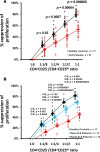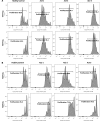ALS patients' regulatory T lymphocytes are dysfunctional, and correlate with disease progression rate and severity
- PMID: 28289705
- PMCID: PMC5333967
- DOI: 10.1172/jci.insight.89530
ALS patients' regulatory T lymphocytes are dysfunctional, and correlate with disease progression rate and severity
Abstract
Neuroinflammation is a pathological hallmark of ALS in both transgenic rodent models and patients, and is characterized by proinflammatory T lymphocytes and activated macrophages/microglia. In ALS mouse models, decreased regulatory T lymphocytes (Tregs) exacerbate the neuroinflammatory process, leading to accelerated motoneuron death and shortened survival; passive transfer of Tregs suppresses the neuroinflammation and prolongs survival. Treg numbers and FOXP3 expression are also decreased in rapidly progressing ALS patients. A key question is whether the marked neuroinflammation in ALS can be attributed to the impaired suppressive function of ALS Tregs in addition to their decreased numbers. To address this question, T lymphocyte proliferation assays were performed. Compared with control Tregs, ALS Tregs were less effective in suppressing responder T lymphocyte proliferation. Although both slowly and rapidly progressing ALS patients had dysfunctional Tregs, the greater the clinically assessed disease burden or the more rapidly progressing the patient, the greater the Treg dysfunction. Epigenetically, the percentage methylation of the Treg-specific demethylated region was greater in ALS Tregs. After in vitro expansion, ALS Tregs regained suppressive abilities to the levels of control Tregs, suggesting that autologous passive transfer of expanded Tregs might offer a novel cellular therapy to slow disease progression.
Conflict of interest statement
Conflict of interest: The authors have declared that no conflict of interest exists.
Figures






References
Publication types
MeSH terms
Substances
Grants and funding
LinkOut - more resources
Full Text Sources
Other Literature Sources
Medical
Miscellaneous

